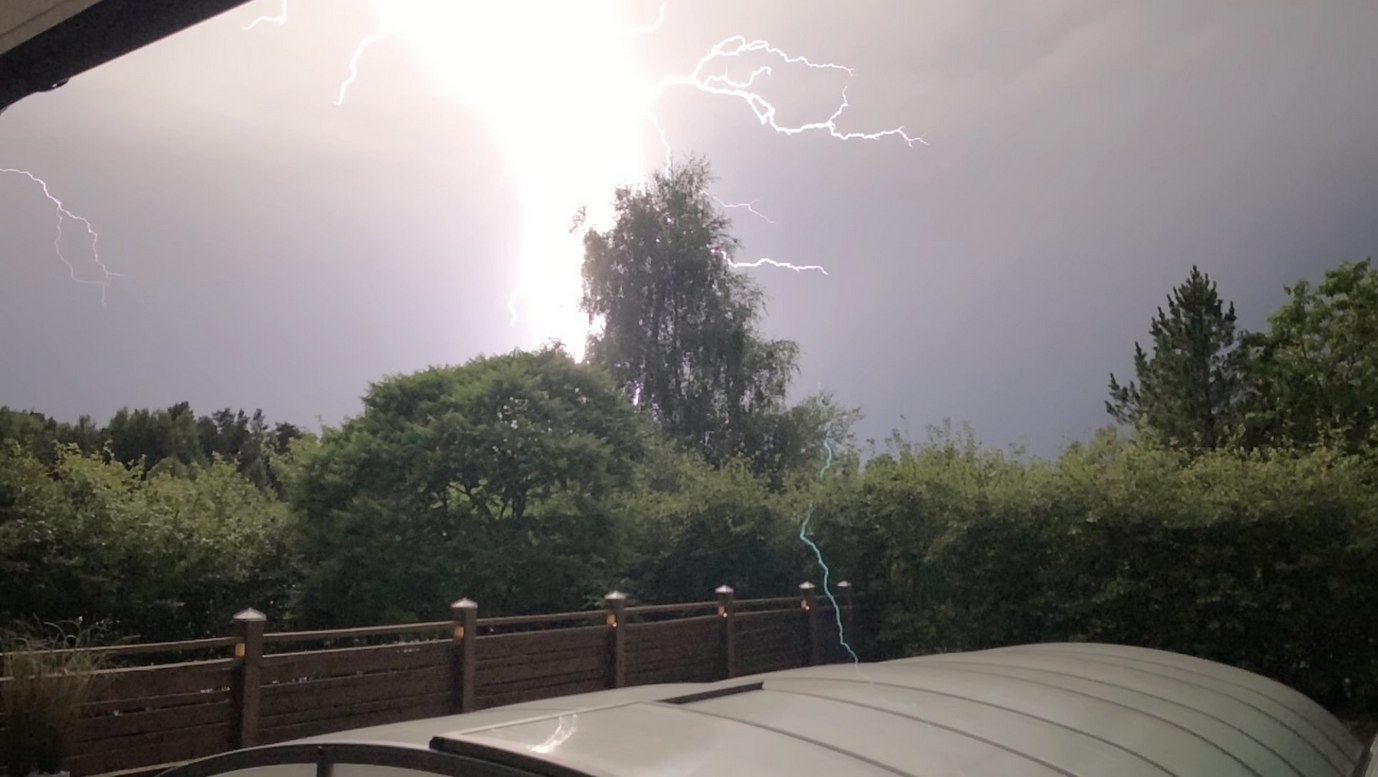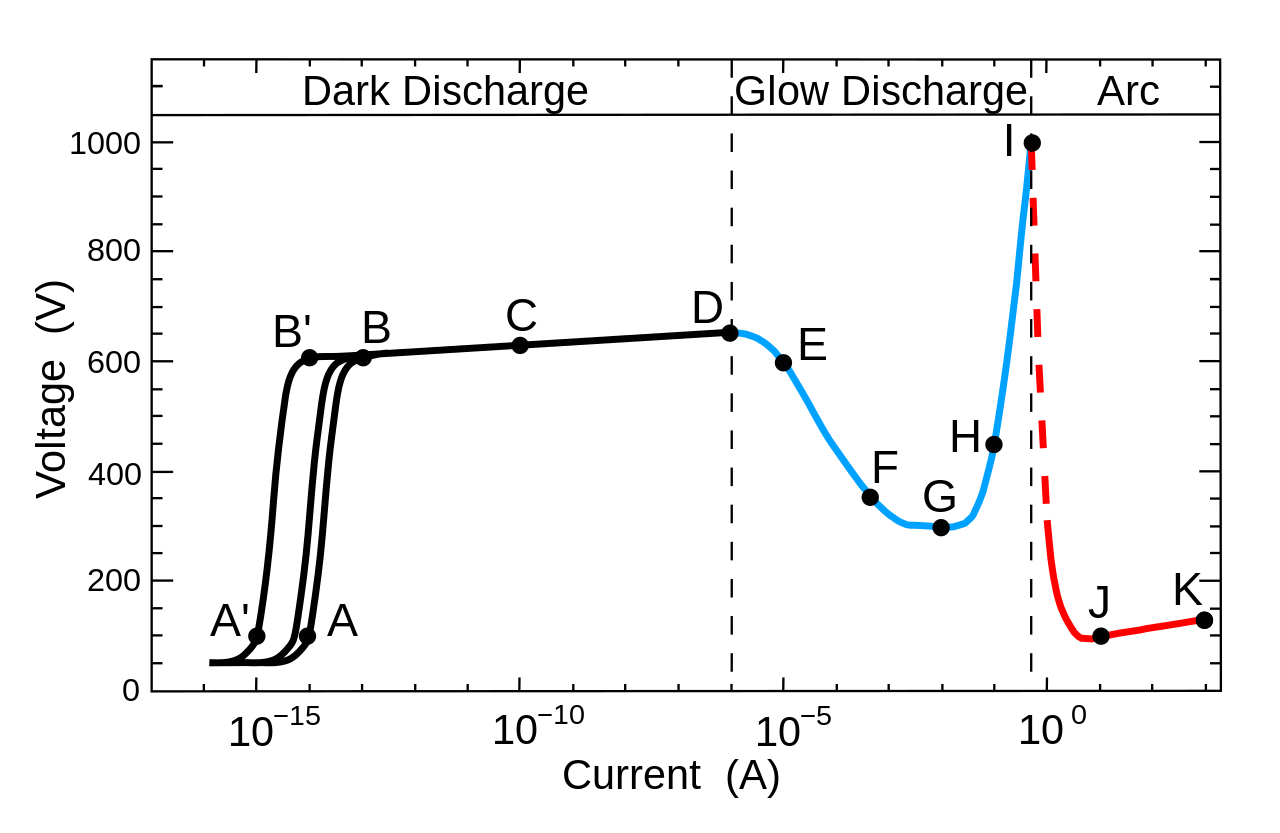We explain the physics of a ball lightning with the physics of arc light. The ball is hold together by surface forces. Similar atmospheric phenomena may be the corona discharge and the aurora borealis. The colour of arc light is also caused by ionised oxygen and nitrogen atoms. In the lucky case, the lines of oxygen and nitrogen can be measured in the spectrum of the ball lightning. Nitrogen oxides are formed by heat, during lightning - and atmospheric arc-light - nitrogen is naturally oxidised to form nitrogen oxides with a characteristic odour, as observed. Thermal ionisation is typical of arc-light, and in the case of corona discharge, collision ionisation is typical of ground-ground ionisation. Both types of ionisation are caused by the negative resistivity (dynamic resistance, which does not exist at zero voltage) state of the plasma, which is considered to be the stability condition of the spherical filament. In the negative-resistance state, the current, i.e. the number of ions, increases as the voltage decreases, and the current is limited only by the conservation laws.
The negative resistance phenomenon of arc light is the explanation for the stability of the spherical lightning. Thermal emission is most intense in the centre of the sphere, which is the cause of the inflating spherical shape. The surface has a lower temperature, is characterised by glowing embers, and the ions recombine at the rim. Overall, the ball lightning is electrically neutral.
INTRODUCTION
The research tool was an internet search, a nice little demo video: https://videa.hu/videok/tudomany-technika/lefilmezett-gombvillam-para-Ak1xNJku6ZX0v6pi . There are many explanations* of spherical lightning covering many topics in physics. The hypotheses assume central force fields, or rarely occurring particles, there is no generally accepted description of spherical lightning, an atmospheric phenomenon. We hypothesise that the ions and electrons in the air that make up the ball lightning can be described by the phenomena of gas discharges.
Literature review*: ball lightning is not a common phenomenon, many explanations have been published but not generally accepted. On atmospheric and lightning physics, see R.P. Feynman-R.B. Leighton-M. Sands, Modern Physics, vol. 5, (p. 120, Technical Publishers, 1969. ETO 53 "19" (082)), where the authors summarize the physics of lightning in the chapter "Atmospheric Electricity". The atmospheric electric potential can be tens of thousands of volts per centimeter, which ionizes oxygen and nitrogen. The real difference in the literature hypotheses is in the quality of the charged particles and the origin of the central force fields that hold them together.
Corona discharge is a similar, colourful, nearly spherical atmospheric ionisation phenomenon, the source of its ions being naturally bound to a location, the Earth's surface, possibly e.g. masts. It is characterised by glowing embers, electron avalanches and negative resistance. It is artificially produced by needle electrodes and requires high voltage. In the case of glowing embers, electron avalanches cause ionisation and also the phenomenon of negative resistance. Negative resistance does not occur at low voltages. At higher voltages (at the ignition voltage), the glow glow is converted into an arc glow under laboratory conditions. In nature, the glow is an uncommon phenomenon that can be captured on high-speed camera images of sharp metal objects, possibly on the tops of masts.

At a voltage lower than the ignition voltage of air, the glow of embers, characterised by electron avalanches, appears. At voltages higher than the ignition voltage of air, the electrons are already sufficiently energetic to be capable of thermal emission, which is the characteristic of arc flash. In plasma, also called hot plasma, there may be multiple ionised atoms, and the temperature can increase by leaps and bounds (up to 10 000 K degrees),
https://en.wikipedia.org/wiki/Thermal_ionization).

B: saturation current
C: avalanche Townsend discharge
D: self-sustained Townsend discharge
E: unstable region: corona discharge (when the voltage decreases, the current increases!)
F: sub-normal glow discharge
G: normal glow discharge
H: abnormal glow discharge
I: unstable region: glow-arc transition
J: electric arc (when the voltage decreases, the current increases!)
K: electric arc
The A-D region is called a dark discharge; there is some ionization, but the current is below 10 microamperes and there is no significant amount of radiation produced.
The F-H region is a region of glow discharge; the plasma emits a faint glow that occupies almost all the volume of the tube; most of the light is emitted by excited neutral atoms.
The I-K region is a region of arc discharge; the plasma is concentrated in a narrow channel along the center of the tube;
In the second negative resistance stage, the increasing current is limited only by conservation laws.The short-term (≈ 10 seconds) stability of ball lightning is explained by the second, negative resistance section.Recombination maintains equilibrium with thermal ionization. The negative (differential or dynamic) resistance is a phenomenon interpreted in plasmas and semiconductors, it occurs at biased loads, i.e. it does not occur at a voltage of U ≈ 0.
Its sources are hard-to-notice ion channels starting from the earth's surface. The ions come from the Earth's surface, the atmospheric tension creates the channels. The channels are not stable phenomena, they are characterized by collisional ionization and gas discharge. The ion channel is characterized by corona discharge, (ember glow, St. Elmo's fire), electron avalanches, and negative resistance (https://en.wikipedia.org/wiki/St._Elmo%27s_fire, cold plasma).
Above the ignition voltage, thermal ionization inside the ball lightning and recombination on its surface are characteristic. Symmetric spheres are the result of heat loss and temperature distribution.The radial density distribution of the ions may show a maximum up to the semi-radius, depending on how far the not yet ionized oxygen and nitrogen molecules penetrate from the outside, from the surface. The recombined air molecules move inside the arch sphere, their movement in the opposite direction would change the atmospheric pressure. Therefore, non-convective energy loss is typical, but rather radiative losses. Due to the poor thermal conductivity of air, the conductive loss is relatively small. Overall, the ball lightning is electrically neutral.
Within the ball lightning, the free path lengths of the electrons and positive ions are decisive, that of the electrons approx. 5.5 times. Collisions reduce the energy of electrons and ions, the energy loss resulting from collisions slows down the movement of particles even in the case of negative resistance. (The movement of ions is also the subject of research in the case of superconductivity - i.e. zero resistance: https://www.popularmechanics.com/science/a62121695/ed.
*Literature review: the ball lightning is not a rare phenomenon, many -though sometimes uncertain- observations have been published:
- History of observations Keul, A. G.: A brief history of ball lightning observations by scientists and trained professionals, Hist. Geo Space. Sci., 12, 43-56, https://doi.org/10.5194/hgss-12-43-2021, 2021.
- https://en.wikipedia.org/wiki/Ball_lightning,
- https://anyanyelvcsavar.blog.hu/2018/07/20/a_villamok_nepi_osztalyozasa_kulonos_tekintettel_
- https://www.britannica.com/story/does-ball-lightning-exist.
- Nicola Tesla may have produced ball lightning (https://en.wikipedia.org/wiki/Colorado_Springs_Notes,_1899%E2%80%931900) using high-voltage and high-frequency devices.
- At the Max Planc Institute (https://phys.org/news/2006-06-physicists-ball-lightning-lab.html), they produced plasma with a high current arc, but for a very short time compared to the lifetime of ball lightning.
- Researchers in Brazil and New Zealand have experimented with silicon evaporation (https://index.hu/tudomany/villam070112/, http://aparadox.hupont.hu/19/05-brazil-gombvillam). Microwave production experiments have also been carried out (https://www.nature.com/articles/srep28263).
**Observed characteristics (https://en.wikipedia.org/wiki/Ball_lightning):
- Floating in an erratic orbit, ("mats"), spinning, rolls,
- destroys, though not always,
- often occurs in thunderstorms, but not exclusively and not necessarily thunderstorm related, although more common in thunderstorms,
- can move upwind, speeds of 1-2 m/sec,
- burning holes in partitions, sometimes passing through without a trace.
- They range from 1 to 100 cm in diameter, most often around 10 cm,
- A wide range of colours have been observed, the most common being red, orange and yellow, rarely bluish, usually opalescent.
- Their lifetime lasts from one second to more than a minute, and the brightness remains relatively constant during this time,
- observers rarely report any sensation of heat, but it will burn any object it comes into contact with. In some cases, the disappearance of the sphere has been accompanied by a strong release of heat.
- Some spheres are attracted to metal objects and move along conductors such as wires or metal fences.
